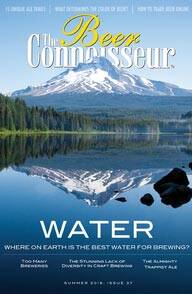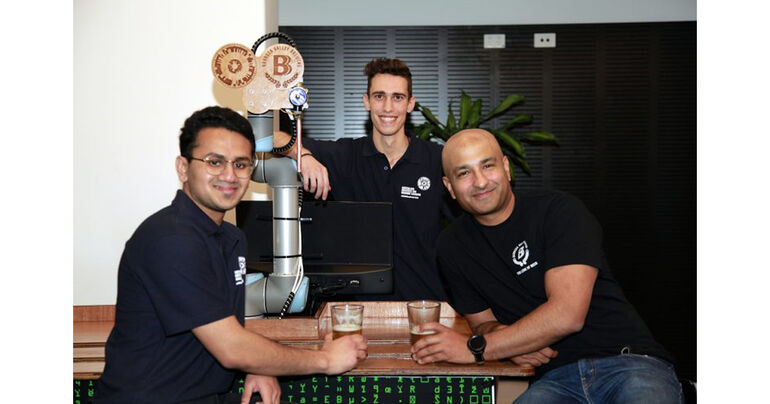Start 14-Day Trial Subscription
*No credit card required

Students in Australia Create an IPA with AI
University of Adelaide students in Australia have created an IPA with AI. Full details are below.
AUSTRALIA – One of the world’s oldest industries now has a high-tech twist, with a new South Australian craft beer designed entirely by artificial intelligence (AI), thanks to a special project from the University of Adelaide’s Australian Institute for Machine Learning (AIML) working in partnership with Barossa Valley Brewing.
As part of their machine learning internship, two University of Adelaide computer science students, Christopher Fusco and Jash Vira, created a neural network that was able to learn how to make beer by studying a vast trove of brewing records. The result is a unique AI-designed IPA which will be available for sale from early next year.
The Rodney AI²PA is named in honour of Rodney Brooks, an Australian robotics pioneer and co-founder of iRobot, the company behind the Roomba robot vacuum cleaner.
Working under the guidance of AIML’s machine learning researchers and Barossa Valley Brewing’s experts, the two students set about building a large dataset from more than 260,000 existing craft beer recipes available online, before creating a neural networkthat learned how to make beer by studying the data.
“We generated 200,000 new recipes, and then we trained a neural network to pick the best ones and rank them,” Christopher said.
Most beer contains only four main ingredients: malt, hops, water and yeast. Slight variations in those ingredients—and precise changes to the times and temperatures at certain steps of the brewing process—result in the diverse variety of beer available today.
But if creating AI that can make its own beer isn’t complex enough, creating AI that can actually make good beer is significantly more challenging.
“That was actually very difficult. We had to come up with our own mathematical formula using statistics from those original recipes,” Christopher said.
“By getting statistics on these variables, we were able to judge the significance of each variable, this also helped us deal with any possible biases that could have occurred in the data,” Jash added.
Data such as how many times particular beer recipes had been viewed online, and how many people said they’d made it, all give an indication as to a beer’s popularity. The students then created a neural network that learned to judge the AI’s own recipes and give each a popularity rating.
AIML’s neural network produced recipes with around 60 data points, or ‘features’, that included not just the required ingredients and quantities, but also specific process information such as how to handle the hops, the yeast fermentation temperature, and boil times; as well as predictive indicators for bitterness (IBU), colour (SRM) and alcohol content (ABV).
The project was not without its technical challenges, with the neural network sometimes outputting strange feature outliers, such as absurdly large or small quantities, or very high temperatures.
“We used some statistical and graphical methods to analyse our data and then decided to cap some of these outliers. This method helped us preserve the inherent variability of the data as well as evaluate if the decision we made appropriately reflected the final product we wanted to create,” Jash said.
The result was 30 potential AI beer candidates. AIML left the final decision on which to brew to the experts at Barossa Valley Brewing.
The brewery’s founder, Denham D’Silva, was excited about the opportunity for AI to augment his company’s creative process, but initially thought the technology was too nascent to add value.
“The willingness to experiment and create interesting and premium beers has been a foundation of the brewery for 16 years. So, to largely place this process in the hands of AI, was in a word, terrifying,” he said.
“Beer is traditionally a very hands-on process, and even more so for a small craft brewery like Barossa Valley. When you’re a smaller craft brewery you can’t compete on scale, so you have to be different and clever.”
Australia’s demand for craft beer is strong. While per-capita consumption of beer, generally, has declined in recent decades, craft beer sales are growing at a rate of 10% per year.
“Most people think of AI and machine learning as something that only the huge tech companies can do. This project has shown us that AI can take our artisanal skills and augment them to allow us to compete.” Denham said.
“It’s really important that small and medium enterprises embrace the opportunities that AI offers. Craft producers need to get involved to ensure AI incorporates the art which makes us special.”
Christopher and Jash plan to continue on their machine learning career paths, with both students intending to pursue postgraduate studies after completing their undergraduate programs at the end of 2022.
“I think it’s a very exciting time for machine learning, because we’re reaching a stage where we can collaborate with other industries using what we know and what we’re good at. There’s a lot of growth in the field,” Christopher said.
To complement the high-tech beer experience, AIML engineers have also built a robotic ‘bartender’ that can automatically detect when an empty glass is placed on the bar, and quickly refill it with cold beer straight from the keg.
As for the important question of what the AI beer actually tastes like, Denham D’Silva is enthusiastic.
“It tastes like the future! Seriously, it’s a fruit driven IPA which I am very proud of and can’t wait to release,” he said.
The Rodney AI²PA by Barossa Valley Brewing will be available for limited retail sale from mid-January 2022.



